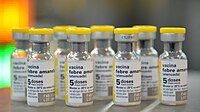
Photo from wikipedia
For administration of multiple live attenuated vaccines, the Advisory Committee on Immunization Practices recommends either simultaneous immunization or period of at least 28days between vaccines, due to a possible reduction… Click to show full abstract
For administration of multiple live attenuated vaccines, the Advisory Committee on Immunization Practices recommends either simultaneous immunization or period of at least 28days between vaccines, due to a possible reduction in the immune response to either vaccine. The main objective of this study was to compare the immune response to measles (alone or combined with mumps and rubella) and yellow fever vaccines among infants aged 6-24months living in a yellow fever non-endemic country who had receivedmeasles and yellow fever vaccines before travelling to a yellow fever endemic area. SUBJECTS AND METHODS A retrospective, multicenter case-control study was carried out in 7 travel clinics in the Paris area from February 1st 2011 to march 31, 2015. Cases were defined as infants immunized with the yellow fever vaccine and with the measles vaccine, either alone or in combination with mumps and rubella vaccine, with a period of 1-27days between each immunization. For each case, two controls were matched based on sex and age: a first control group (control 1) was defined as infants having received the measles vaccine and the yellow fever vaccine simultaneously; a second control group (control 2) was defined as infants who had a period of more than 27days between receiving the measles vaccine and yellow fever vaccine. The primary endpoint of the study was the percentage of infants with protective immunity against yellow fever, measured by the titer of neutralizing antibodies in a venous blood sample. RESULTS One hundred and thirty-one infants were included in the study (62 cases, 50 infants in control 1 and 19 infants in control 2). Of these, 127 (96%) were shown to have a protective titer of yellow fever antibodies. All 4 infants without a protective titer of yellow fever antibodies were part of control group 1. DISCUSSION The measles vaccine, alone or combined with mumps and rubella vaccines, appears to have no influence on humoral immune response to the yellow fever vaccine when administered between 1 and 27days. The absence of protective antibodies against yellow fever was observed only among infants who received both vaccines simultaneously. CONCLUSION These results may support a revision of current vaccination recommendations concerning the administration of these two live attenuated vaccines either on the same day or at least 28days apart. Our findings show no statistically significant difference if the interval between both vaccines is more than 24 h, but the immune response seems to be reduced when the two vaccines are given at the same time.
Journal Title: Vaccine
Year Published: 2017
Link to full text (if available)
Share on Social Media: Sign Up to like & get
recommendations!